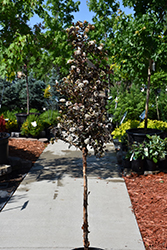It's all about ...
plants

Summer Wine® Ninebark (tree form)
Physocarpus opulifolius 'Seward'
Height: 8 feet
Spread: 6 feet
Sunlight:
![]()
![]()
Hardiness Zone: 2b
Other Names: Eastern Ninebark
Brand: Proven Winners
Description:
This stunning accent tree has all the charm and color of its parent Diablo but in a more dense, compact form; foliage emerges a wine-red and fades to reddish-purple, setting apart the showy white flowers in spring, also has curious peeling bark
Ornamental Features
Summer Wine® Ninebark (tree form) features showy clusters of white flowers at the ends of the branches from late spring to early summer, which emerge from distinctive pink flower buds. It has attractive deep purple deciduous foliage which emerges crimson in spring. The serrated lobed leaves are highly ornamental and turn an outstanding red in the fall. It features abundant showy red capsules from early to mid fall. The peeling tan bark and dark red branches add an interesting dimension to the landscape.
Landscape Attributes
Summer Wine® Ninebark (tree form) is a deciduous tree, selected and trained to grow in a small tree-like form with the primary plant grafted high atop a standard. Its relatively fine texture sets it apart from other landscape plants with less refined foliage.
This tree will require occasional maintenance and upkeep, and can be pruned at anytime. It has no significant negative characteristics.
Summer Wine® Ninebark (tree form) is recommended for the following landscape applications;
- Accent
- Mass Planting
- Hedges/Screening
- General Garden Use
Planting & Growing
Summer Wine® Ninebark (tree form) will grow to be about 8 feet tall at maturity, with a spread of 6 feet. It tends to be a little leggy, with a typical clearance of 4 feet from the ground, and is suitable for planting under power lines. It grows at a medium rate, and under ideal conditions can be expected to live for approximately 30 years.
This tree does best in full sun to partial shade. It is very adaptable to both dry and moist locations, and should do just fine under average home landscape conditions. It is not particular as to soil type or pH. It is highly tolerant of urban pollution and will even thrive in inner city environments. This is a selection of a native North American species.

